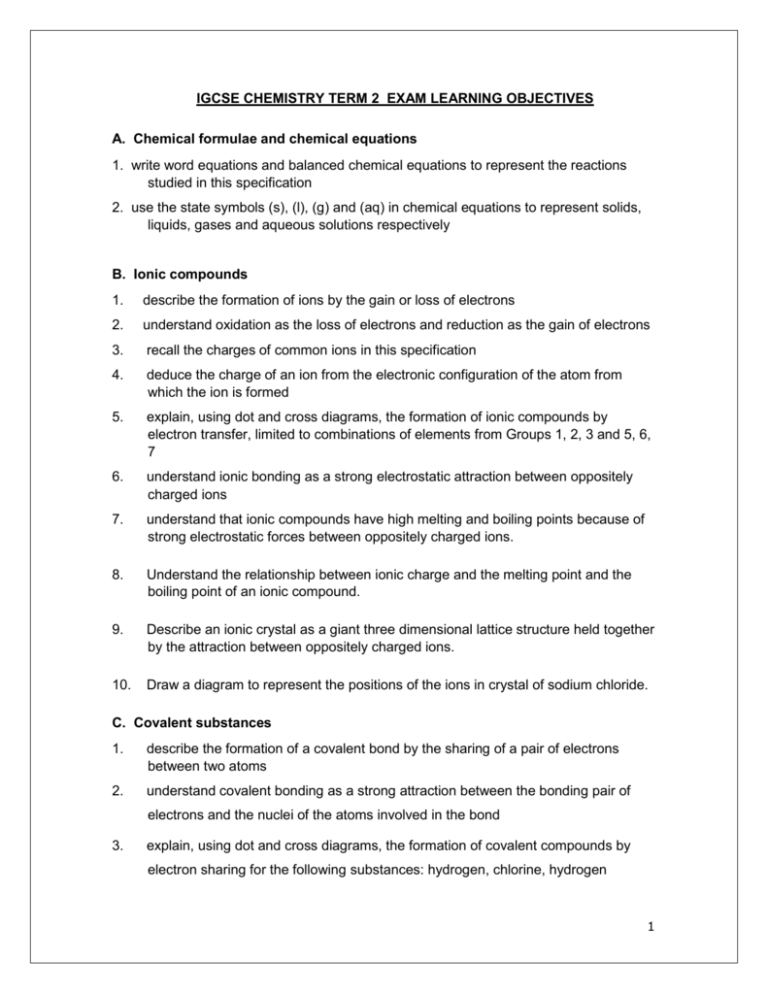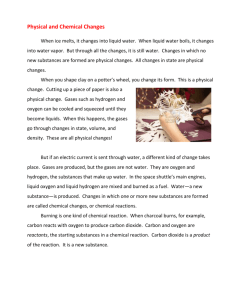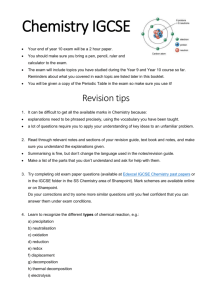Y10Ch
advertisement

IGCSE CHEMISTRY TERM 2 EXAM LEARNING OBJECTIVES A. Chemical formulae and chemical equations 1. write word equations and balanced chemical equations to represent the reactions studied in this specification 2. use the state symbols (s), (l), (g) and (aq) in chemical equations to represent solids, liquids, gases and aqueous solutions respectively B. Ionic compounds 1. describe the formation of ions by the gain or loss of electrons 2. understand oxidation as the loss of electrons and reduction as the gain of electrons 3. recall the charges of common ions in this specification 4. deduce the charge of an ion from the electronic configuration of the atom from which the ion is formed 5. explain, using dot and cross diagrams, the formation of ionic compounds by electron transfer, limited to combinations of elements from Groups 1, 2, 3 and 5, 6, 7 6. understand ionic bonding as a strong electrostatic attraction between oppositely charged ions 7. understand that ionic compounds have high melting and boiling points because of strong electrostatic forces between oppositely charged ions. 8. Understand the relationship between ionic charge and the melting point and the boiling point of an ionic compound. 9. Describe an ionic crystal as a giant three dimensional lattice structure held together by the attraction between oppositely charged ions. 10. Draw a diagram to represent the positions of the ions in crystal of sodium chloride. C. Covalent substances 1. describe the formation of a covalent bond by the sharing of a pair of electrons between two atoms 2. understand covalent bonding as a strong attraction between the bonding pair of electrons and the nuclei of the atoms involved in the bond 3. explain, using dot and cross diagrams, the formation of covalent compounds by electron sharing for the following substances: hydrogen, chlorine, hydrogen 1 chloride, water, methane, ammonia, oxygen, nitrogen, carbon dioxide, ethane, ethene. 4. understand that substances with simple molecular structures are gases or liquids, or solids with low melting points 5. explain why substances with simple molecular structures have low melting and boiling points in terms of the relatively weak forces between the molecules 6. explain the high melting and boiling points of substances with giant covalent structures in terms of the breaking of many strong covalent bonds 7. Draw diagrams representing the positions of the atoms in diamond and graphite. 8. Explain how the uses of diamond and graphite depend on their structures, limited to graphite as a lubricant and diamond in cutting. D. Metallic crystals 1. understand that a metal can be described as a giant structure of positive ions surrounded by a sea of delocalised electrons 2. explain the electrical conductivity and malleability of a metal in terms of its structure and bonding. E. The Periodic Table 1. understand the terms group and period 2. recall the positions of metals and non-metals in the Periodic Table 3. explain the classification of elements as metals or non-metals on the basis of their electrical conductivity and the acid-base character of their oxides 4. understand why elements in the same group of the Periodic Table have similar chemical properties 5. understand that the noble gases (Group 0) are a family of inert gases and explain their lack of reactivity in terms of their electronic configurations. F. Group 1 elements — lithium, sodium and potassium 1. describe the reactions of these elements with water and understand that the reactions provide a basis for their recognition as a family of elements 2. describe the relative reactivities of the elements in Group 1. 3. Explain the relative reactivities of the elements in Group 1 in terms of distance between the outer electron and the nucleus. 2 G. Group 7 elements — chlorine, bromine and iodine 1. recall the colours and physical states of the elements at room temperature 2.9 make predictions about the properties of other halogens in this group 2. understand the difference between hydrogen chloride gas and hydrochloric acid 3. explain, in terms of dissociation, why hydrogen chloride is acidic in water but not in methylbenzene 4. describe the relative reactivities of the elements in Group 7 5. describe experiments to demonstrate that a more reactive halogen will displace a less reactive halogen from a solution of one of its salts 6. understand these displacement reactions as redox reactions. H. Oxygen and oxides 1. recall the gases present in air and their approximate percentage by volume 2. explain how experiments involving the reactions of elements such as copper, iron and phosphorus with air can be used to investigate the percentage by volume of oxygen in air 3. describe the laboratory preparation of oxygen from hydrogen peroxide, using manganese(IV) oxide as a catalyst 4. describe the reactions of magnesium, carbon and sulfur with oxygen in air, and the acid-base character of the oxides produced 5. describe the laboratory preparation of carbon dioxide from calcium carbonate and dilute hydrochloric acid 6. describe the formation of carbon dioxide from the thermal decomposition of metal carbonates such as copper(II) carbonate 7. describe the properties of carbon dioxide, limited to its solubility and density 8. explain the use of carbon dioxide in carbonating drinks and in fire extinguishers, in terms of its solubility and density 9. understand that carbon dioxide is a greenhouse gas and may contribute to climate change. I. Hydrogen and water 1. describe the reactions of dilute hydrochloric and dilute sulfuric acids with magnesium, aluminium, zinc and iron 2. describe the combustion of hydrogen 3. describe the use of anhydrous copper(II) sulfate in the chemical test for water 4. describe a physical test to show whether water is pure. 3 J. Reactivity series 1. understand that metals can be arranged in a reactivity series based on the reactions of the metals and their compounds: potassium, sodium, lithium, calcium, magnesium, aluminium, zinc, iron, copper, silver and gold 2. describe how reactions with water and dilute acids can be used to deduce the following order of reactivity: potassium, sodium, lithium, calcium, magnesium, zinc, iron and copper 3. deduce the position of a metal within the reactivity series using displacement reactions between metals and their oxides, and between metals and their salts in aqueous solutions 4. understand oxidation and reduction as the addition and removal of oxygen respectively 5. understand the terms redox, oxidising agent and reducing agent 6. describe the conditions under which iron rusts 7. describe how the rusting of iron may be prevented by grease, oil, paint, plastic and galvanising 8. understand the sacrificial protection of iron in terms of the reactivity series. K. Tests for ions and gases 1. describe tests for the cations: i Li+, Na+, K+ Ca2+, using flame tests ii NH4+, using sodium hydroxide solution and identifying the ammonia evolved iii Cu2+, Fe2+ and Fe3+, using sodium hydroxide solution 2. describe tests for the anions: i Cl-, Br- and I-, using dilute nitric acid and silver nitrate solution ii SO42-, using dilute hydrochloric acid and barium chloride solution iii CO32-, using dilute hydrochloric acid and identifying the carbon dioxide evolved 3. describe tests for the gases: i hydrogen ii oxygen iii carbon dioxide iv ammonia v chlorine. vi 4 Pre-Knowledge: - The students should revise the following topics: Atomic number, mass number, electronic configuration, atom, molecule, compound, mixtures, ions, valency of atoms and valency of polyatomic groups. Resources: You should study from Study guide (exercises), notebook, worksheets, assessment sheets and CLG assignments. 5







